You might be a beginner musician, or you might have been playing for years. Regardless, deciding which musical instrument is right for you can be challenging. In this list of musical instruments, you can better understand what’s out there and find the perfect instrument for you.
Woodwind Instruments
Bassoon
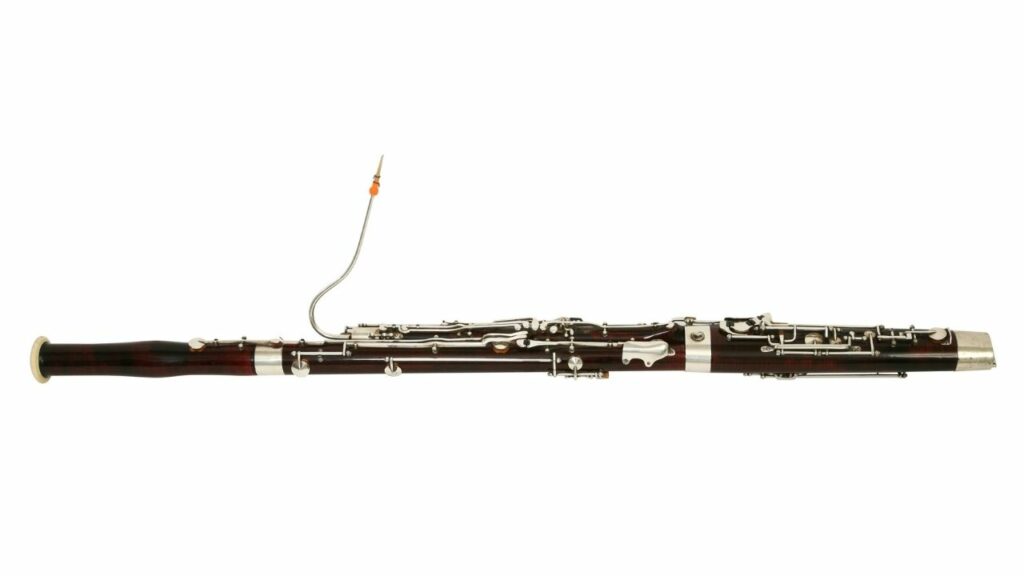
Kick-starting the woodwind instruments list is the bassoon. Think of it as a long wooden pipe folded into two and containing many keys. Its distinctive shape is not for aesthetics; it is more of a functional feature to minimize its entire length and help the player handle it easily.
The bassoon relies on a double reed attached to a curved mouthpiece made from metal to produce its distinct low-range sound or lower notes. You can play this woodwind by positioning it upright and blowing air into the double reed. While at it, you must use both hands to press the keys to control the pitch.
Fun fact: The bassoon dates back to as early as the 16th century, thanks to its predecessors: the rankett, the shawm, and the dulcian.
Contrabassoon
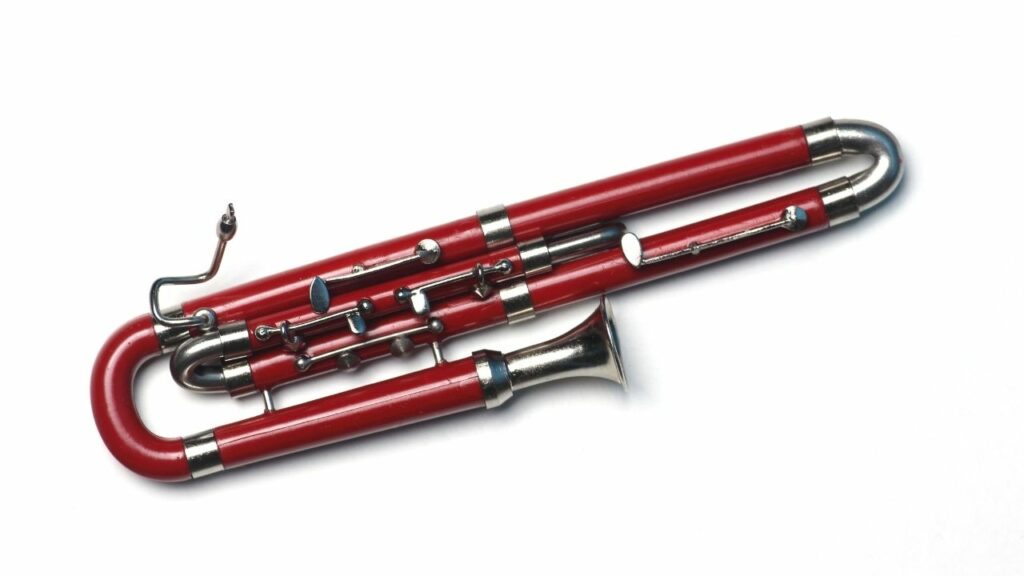
The contrabassoon is a close cousin of the bassoon – it’s like a more extended version but with a wider pipe. It closely resembles the bassoon that some people call it the double bassoon.
The contrabassoon dates many centuries back and was not ushered into the orchestra until later in the 18th century. Being rather lengthy, producing sound from a contrabassoon takes a lot of breath. For that reason, it typically plays the lowest notes in an orchestra.
Flutes
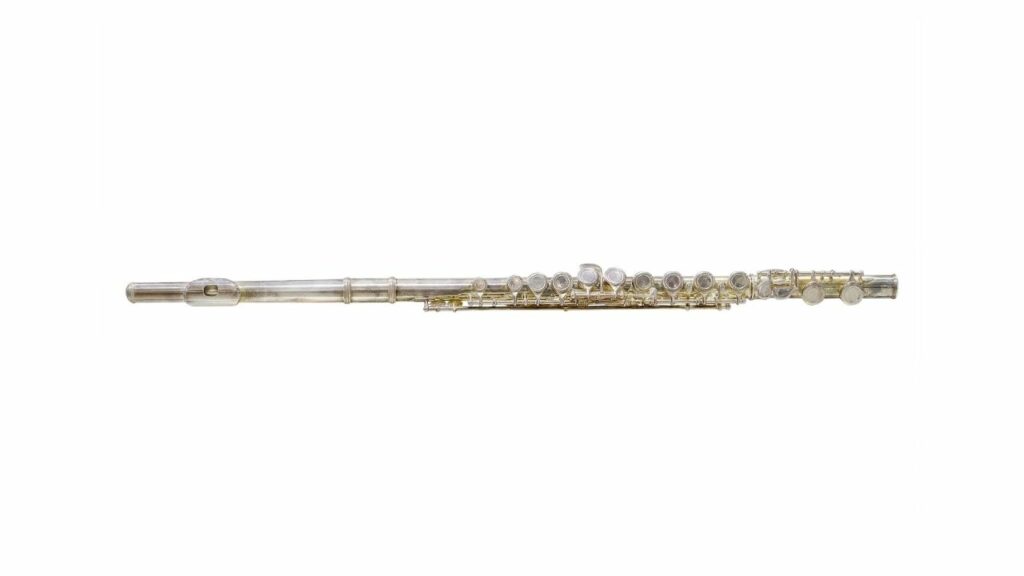
Flutes are among the oldest musical instruments, with roots pointing back to the Paleolithic period. The flutes of this age were initially made out of animal bones but later transitioned into an enhanced version in the 16th century.
Part of the refinement journey involved migrating from wooden, clay, stone, and plant-inspired flutes to the modern silver, platinum, and gold flutes. Coming in a standard size of about 2 feet, playing the flute is easier than some of its giant counterparts.
All you have to do is hold it sideways using both hands and blow across the mouthpiece hole. While at it, you also use your fingers to operate the keys and get your pitch right.
Recorder
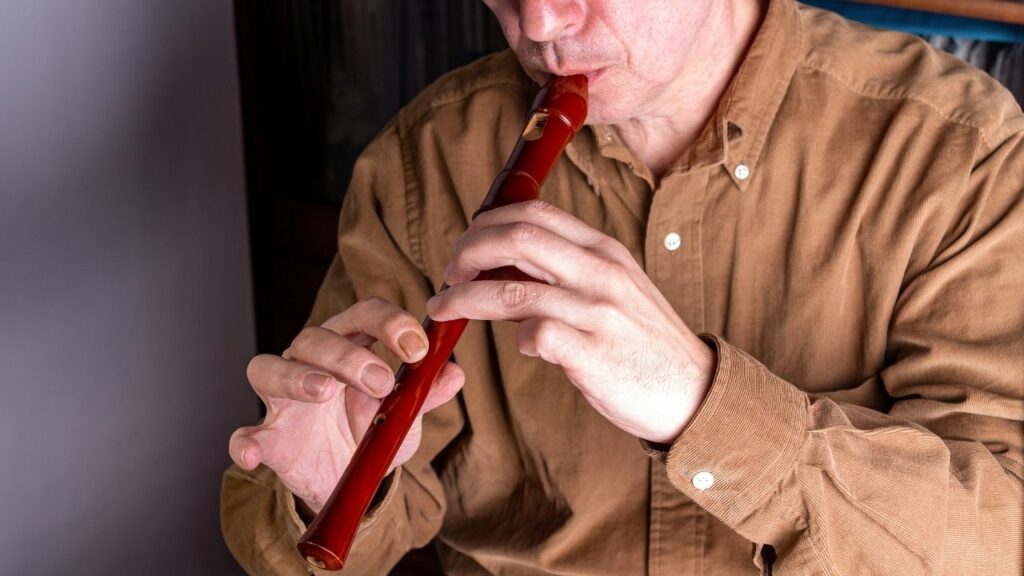
A recorder is an ancient musical instrument belonging to the flute family. It features a fipple or whistle mouthpiece, seven fingerholes on the front, and a thumbhole on the back. Initially, the recorder was made from wood and ivory and featured different sizes.
The earliest version of the recorder emerged in the 14th century and was made of plain wood. However, the modern recorder surfaced in the late 17th century thanks to the lively inspiration of the Renaissance era. It then reached its peak during the Baroque period before losing popularity again in the 18th century.
Oboe
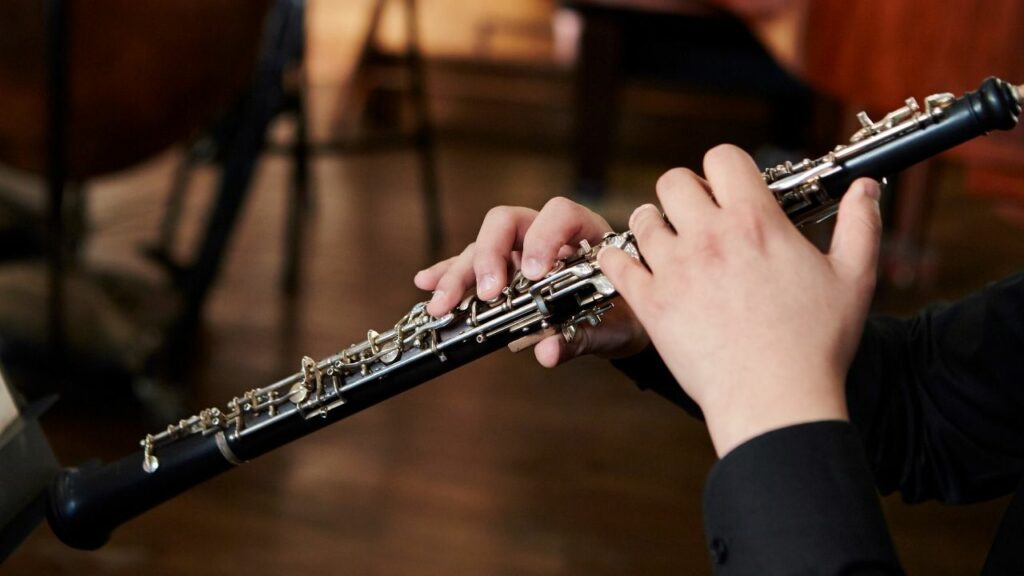
The oboe is one interesting double-reed instrument in the woodwind family. Thanks to its ancient roots, it is not only distinct but also beautiful to play.
Although some historians argue oboes date back as far as the 12th century B.C., the modern soprano oboes gained prominence during the 17th century. Earlier versions of the oboe had a conical shape crafted from wood. They also featured a flared bell and came in different lengths to produce varying pitches.
To play the oboe, you simply hold it upright and blow across the double reed while applying both hands on the keys to regulate the pitch. Thanks to their wide-ranged pitches, oboes mostly come in handy when tuning an orchestra prior to the real performance.
Piccolo
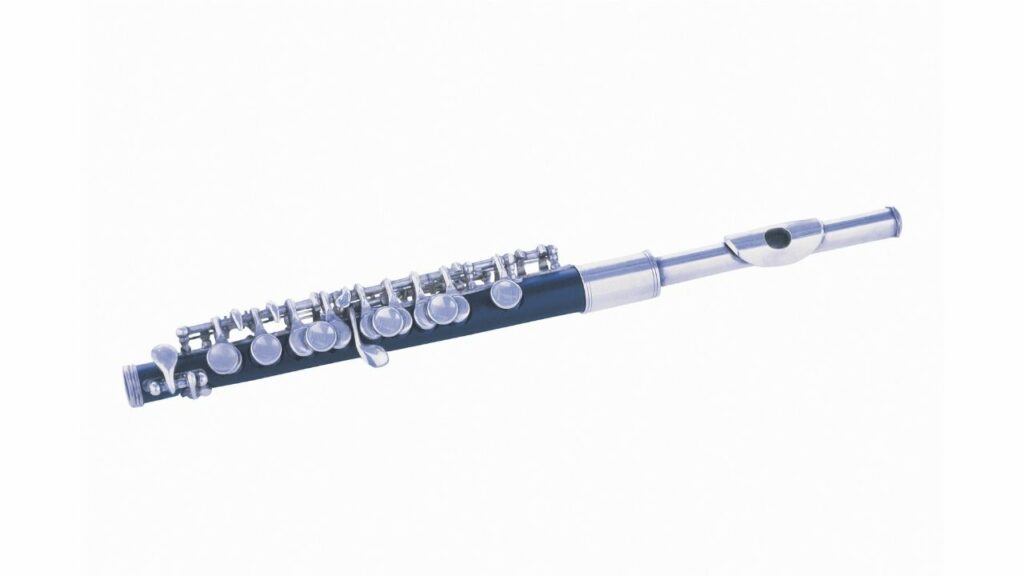
The piccolo is one of the tiniest members of the woodwind family, measuring only half the size of a typical flute. Thanks to the small size, the piccolo produces higher notes that add uniqueness to classical music.
This tiny instrument traces its origins back to military bands between the early 17th century and 18th century. It gradually evolved from the initial transverse flute that was popular in the Middle Ages. As the flute underwent improvements, the same would also be replicated on the piccolo, paving the way for faster piccolo evolution.
Initially, piccolos were made of wood and adopted a conical shape. Later on, however, piccolos would be made of metal to become an important element in the modern orchestra. Generally, to learn to play the piccolo, you should fully master playing the flute first.
Saxophone
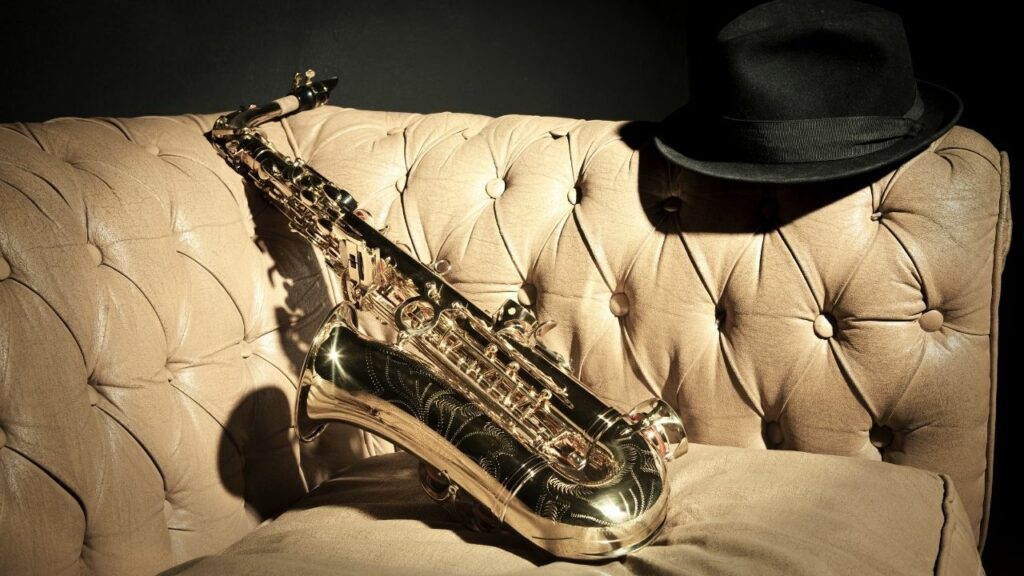
Invented by Adolphe Sax in the 1800s, the saxophone has risen in popularity to become a widely used wind instrument in modern orchestras and jazz bands.
Fun fact: The saxophone was inspired from woodwind and brass instruments. It was initially made of brass. However, based on how it produces sound, it ended up being classified as a woodwind instrument.
Typically, a saxophone comprises a neck, body, bottom elbow, and a round flared bell. To play a large saxophone, you attach a single-reed mouthpiece on its neck and start blowing into it.
However, smaller instruments come with the mouthpiece attached directly to the body. As you blow into the mouthpiece, your fingers press and release keys accordingly to attain the desired pitch.
English Horns
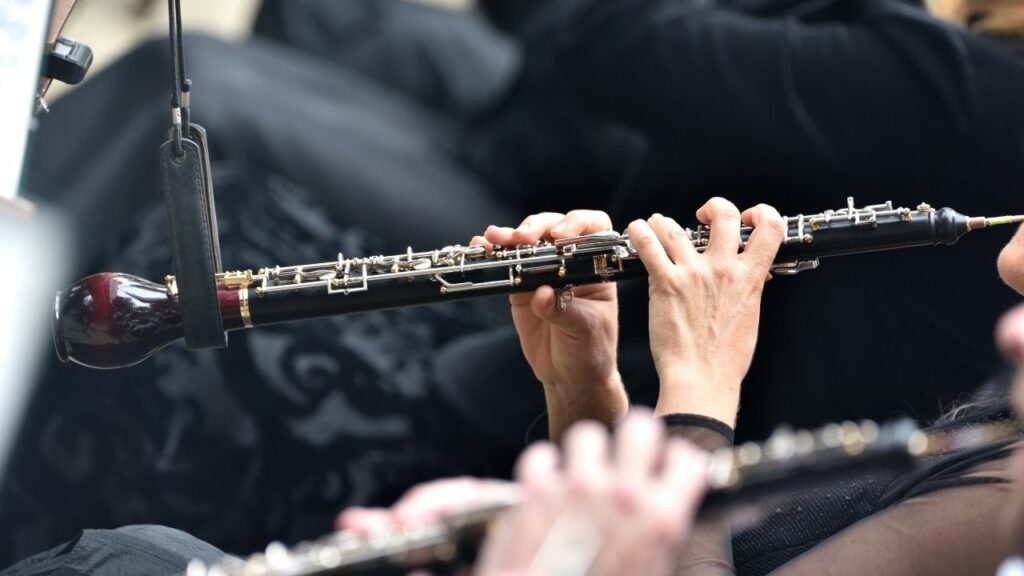
The English horn is a double-reed woodwind instrument that closely resembles the instruments in the oboe family. Nonetheless, although siblings and played in a similar manner, the English horn is longer and features a wider tube.
What’s more, the English horn terminates in a rounded bell for an overall distinct look and produces lower pitch sounds compared to its oboe counterpart. You can play the instrument either seated or standing by holding it vertically in front of yourself. Then, insert the reed into your mouth and press it between your lips.
Today’s English horn emerged in the early 1700s as an improvement to the initial version of the oboe. In 1749, it found its way into the orchestra and continued to gain prominence through Italian opera. By the mid-1800s, the English horn saw more advanced technical developments that ushered it into the modern orchestra.
Membranophone
Tamak
If you’ve ever been to India, you might have heard the tamak. It’s a traditional double-headed drum played by the Santal people, and it produces a deep, rich sound that often serves as the bass for rhythmic dancing.
The tamak is made with thin metal sheets covered in cowhide and wrapped with rope. The body is sometimes deep and barrel-like and sometimes more like a shallow bowl, but the membrane stretched over the top is always tight. It’s played by striking the membrane with drumsticks.
The tamak isn’t well-known outside of India, but it has great cultural significance to the Santal people.
Kazoo
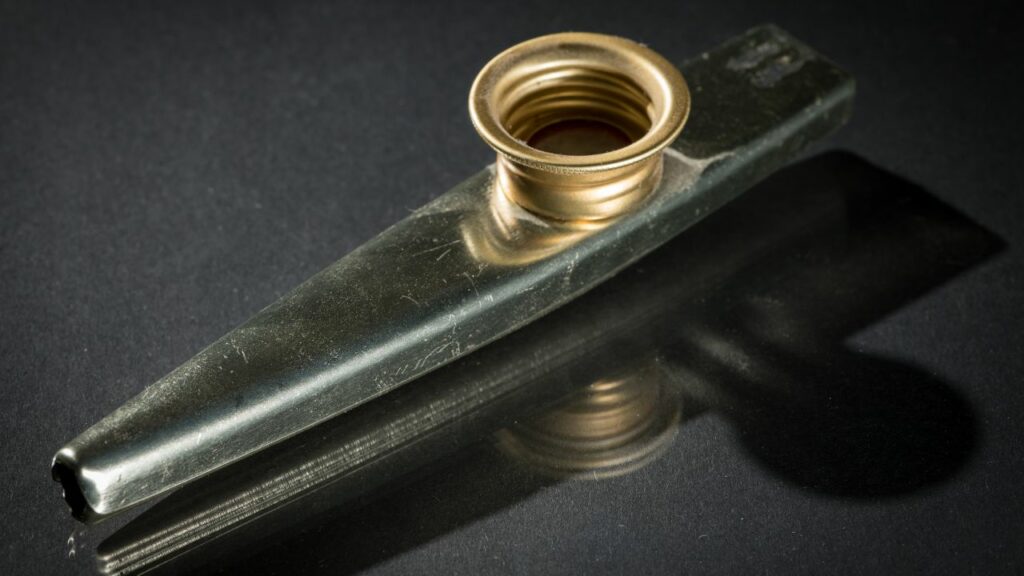
You might think of the kazoo as a wind instrument, but it’s actually a membranophone. It just looks like a flute. You play it by humming rather than blowing, and within its long, cylindrical air chamber, the oscillated air strikes a membrane and produces sound. You can also produce other sounds on the kazoo with wordless vocalizations such as “doo,” “too,” “rrr,” and “brr.”
Variations of the kazoo have existed in Africa for hundreds of years, but the first ones to resemble the modern instrument date back to America in the 1800s. Kazoo playing really took off in the 1920s with the rise of jazz bands and jug bands. It was a common staple in musicals, festivals, dance halls, and vaudeville shows.
Fun fact: The kazoo is one of the only membranophones that isn’t a drum.
Timpani
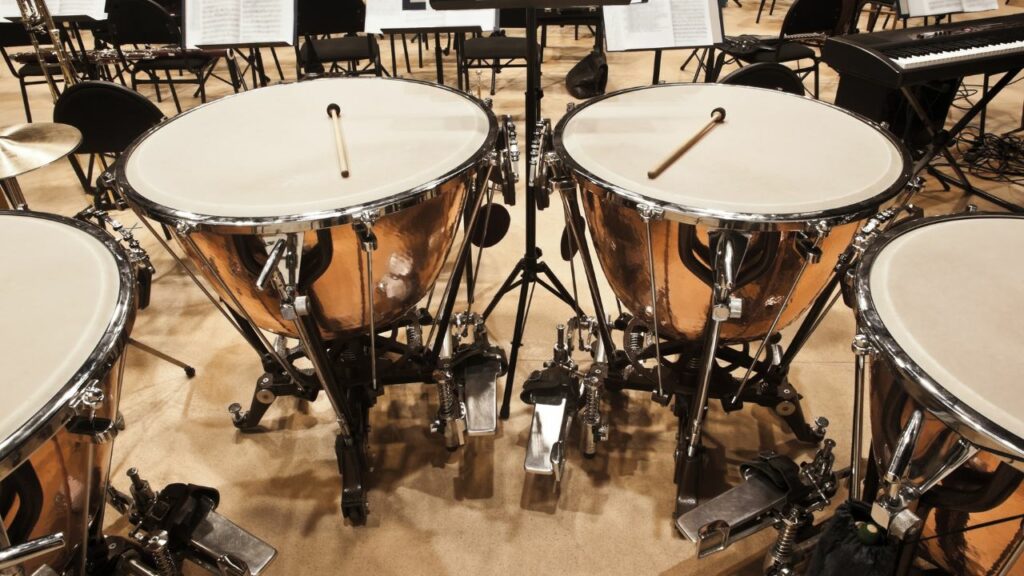
Also known as “timps” or “kettle drums,” timpani are a kind of hemispherical drum that are common in orchestras and marching bands. They have large bowls and membranes traditionally made from animal skins. Less expensive models use plastic membranes.
A distinguishing feature of the timpani is that its pitch is controlled by pedal. Pedal systems can be grouped in three categories: ratchet clutch system, friction clutch system, and balanced action system. Each system has its own pros and cons for the timpanist.
Etymologically speaking, timpani is an Italian word derived from the Latin for “hand drum,” and it’s actually plural. A single drum is called a timpano. A lot of people don’t know this and will mistakenly label multiple drums “timpanis.”
You need at least four timpani to play moderately complex music, including classic music.
Snare Drum
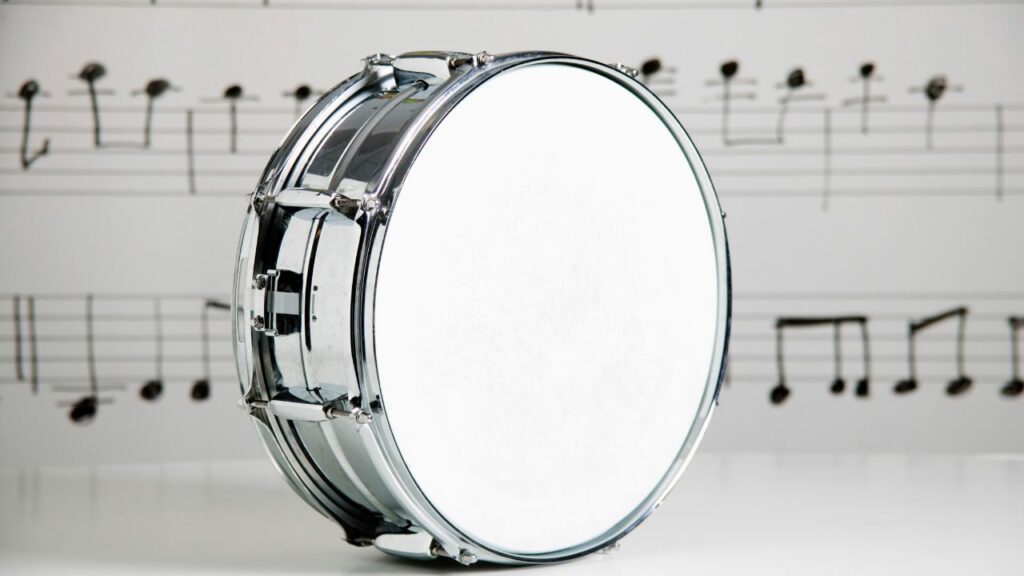
You’ll find snare drums on most membranophone instruments lists. They’re the most widely recognized drums in both appearance and sound, and they’re ubiquitous in rock bands, orchestras, drum lines, and more.
Why are snare drums so popular? It’s probably because they’re so distinctive. Rather than just stretching a membrane over a bowl or barrel, they place a series of stiff wires across the bottom of the drumhead. This creates a sharp staccato sound, also known as a “hiss,” which has become one of the most defining drum sounds of modern music.
Snare drums are considered essential pieces in a drum set, but you can also buy them on their own.
Bongos
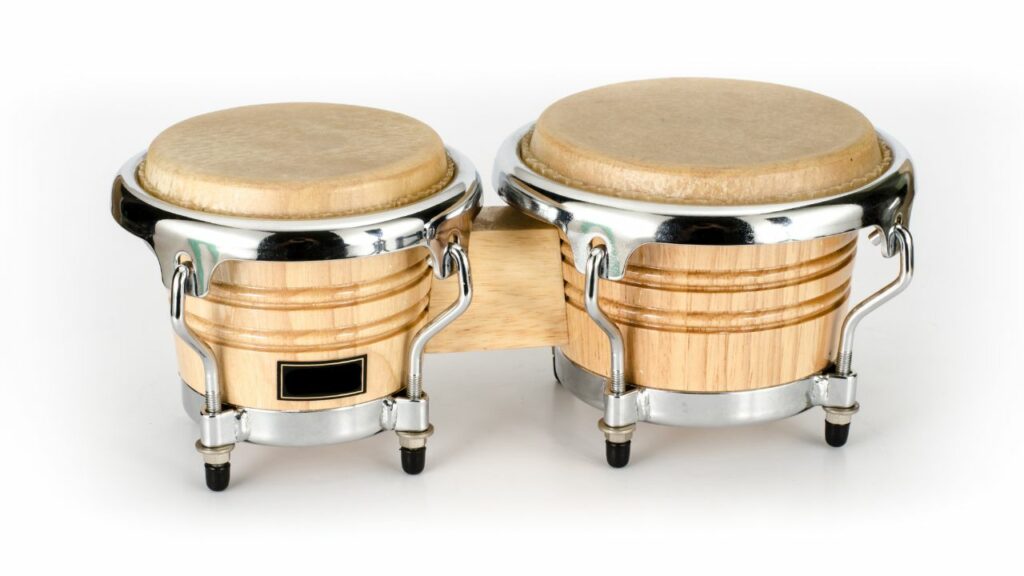
A staple of Afro-Cuban music, bongos are small, open-bottomed drums that are played by hand. Players are called bongosero. Despite their fun, jaunty sounds, they’re capable of producing very complex sequences of music, including the eight-stroke pattern known as martillo or “hammer.”
You might be most familiar with bongos in the context of salsa music, but they’re also popular in everything from jazz to pop to even rock.
Bongo drums are played in pairs. While amateur sets might make both drums the same size, traditional and professional bongo sets have a larger and smaller drum, respectively called the “male” and “female.”
Djembe
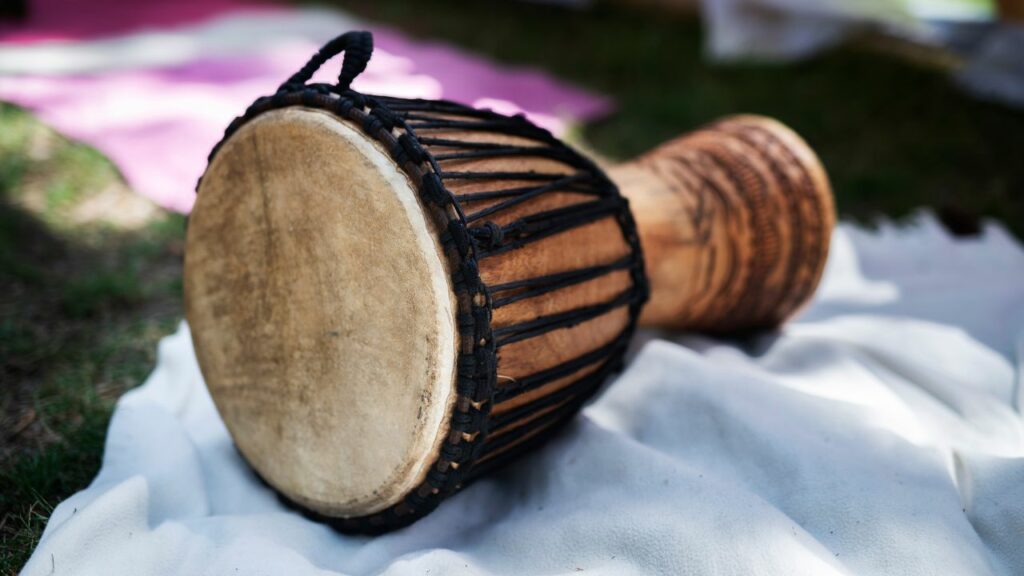
Invented in West Africa, the djembe is a type of goblet drum characterized by its goblet-shaped body and animal skin membrane. Its shell is usually carved out of hardwood and decorated with strings, beads, and painted objects that are important to the player or their tribe.
The name djembe comes from a West African phrase that translates to “everyone gather together in peace,” which is said to be the purpose of the djembe. Playing it is also described as “making the djembe talk.”
The djembe has a loud, distinctive sound that can be easily heard over other instruments, making it ideal for rhythmic chants and festive dances.
Bass Drum
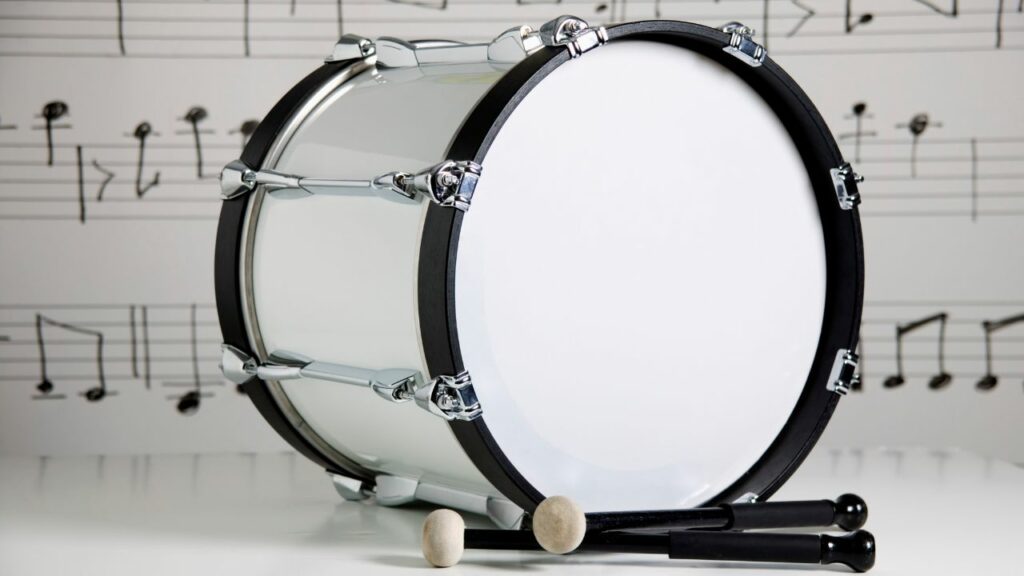
Also called “kick drums,” bass drums are another one that you’ll find on many membranophone instruments lists. While not as recognizable as, say, snare drums, they’re still part of your standard five-piece drum kits.
The most distinguishing feature of the bass drum is its sound. It produces deep, resonant vibrations with indefinite pitch. For this reason, bass drums are often used to mark or keep time during a musical performance. They can also create rolls, climactic single strokes, and special effect sounds meant to mimic thunder or earthquakes.
Tom-Tom
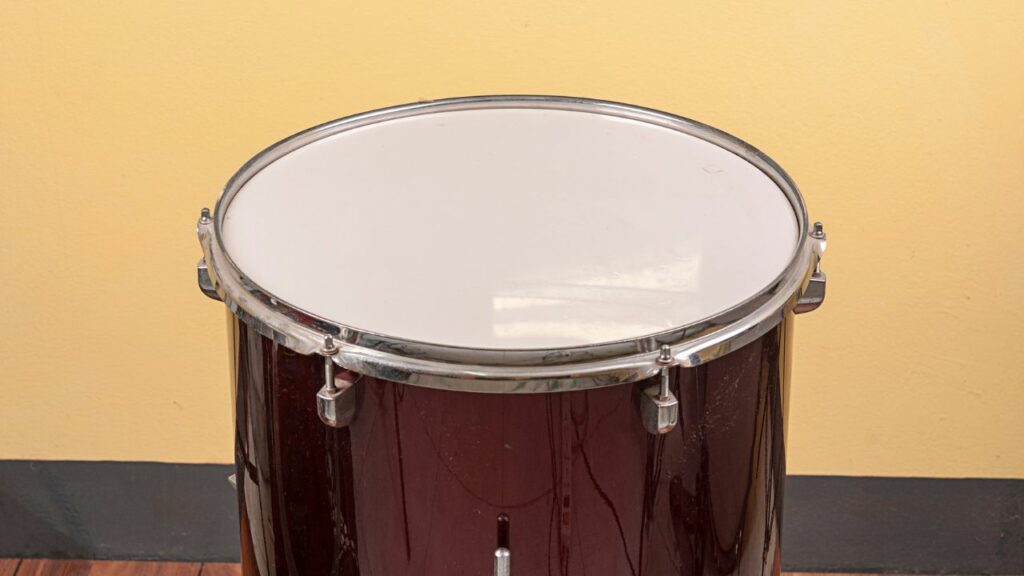
Another essential piece of 21st century drum kits, tom-toms are cylindrical drums that can be tuned to various pitches. They were originally brought to the U.S. in the 1800s by immigrants from around the globe.
There are four different types of tom-tom. The most common is the floor tom, a larger instrument with a drum shell that stands on three legs or gets attached to a cymbal stand. Other models are the rack toms, roto toms, and concert toms.
It’s believed that “tom-tom” is an onomatopoeia for the sound that’s made when striking them.
Tabla

The tabla are small twin drums played by hand. Originally hailing from India, they’ve become popular all across Asia and the Middle East, and you can find them played today everywhere from Bangladesh to Sri Lanka. The word tabla actually comes from the Arabic word tabl meaning “drum.”
While they can be played anywhere and anytime, they have particular significance to Hinduism and Sikhism, and they’re often part of religious songs and ceremonies.
As with many others on this membranophone instruments list, the tabla are considered struck membranophones according to the Hornbostel-Sachs classification.
Comb and Paper
Comb and paper is a unique handmade instrument. Like its name suggests, it’s made from just a hair comb and a sheet of paper. After the paper is folded in half and the comb is slipped inside, the player blows or vocalizes against it to trigger vibrations that create sound.
Despite its rudimentary design, comb and paper can be classified as a membranophone. It’s not unlike a kazoo in the sense that it looks like a wind instrument but is actually defined by its vibrating stretched membrane.
Comb and paper has actually been heard on the radio thanks to its usage in popular songs like “Lovely Rita” by the Beatles and “Crosstown Traffic” by Jimi Hendrix.
Tambourine
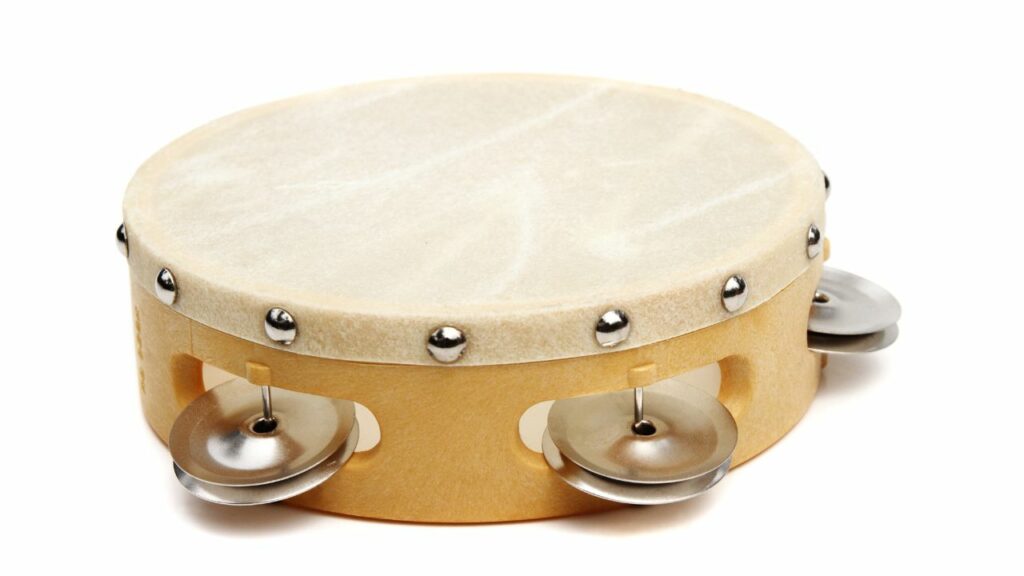
Tambourines have been around since 1700 BC, and they’ve taken many forms since then, including some that aren’t actually membranophones. For example, the jingly plastic tambourines that you played in elementary school are considered idiophones; their sounds are produced by vibrating objects, not vibrating membranes.
Tambourines with membranes do exist, however, and they exist around the world. In Arabic music, they’re known as riqs. In Russian music, they’re known as bubens.
Most tambourines are played by hand, but they can also be hit with sticks or struck against the hips or other body parts.
Idiophones
Castanets
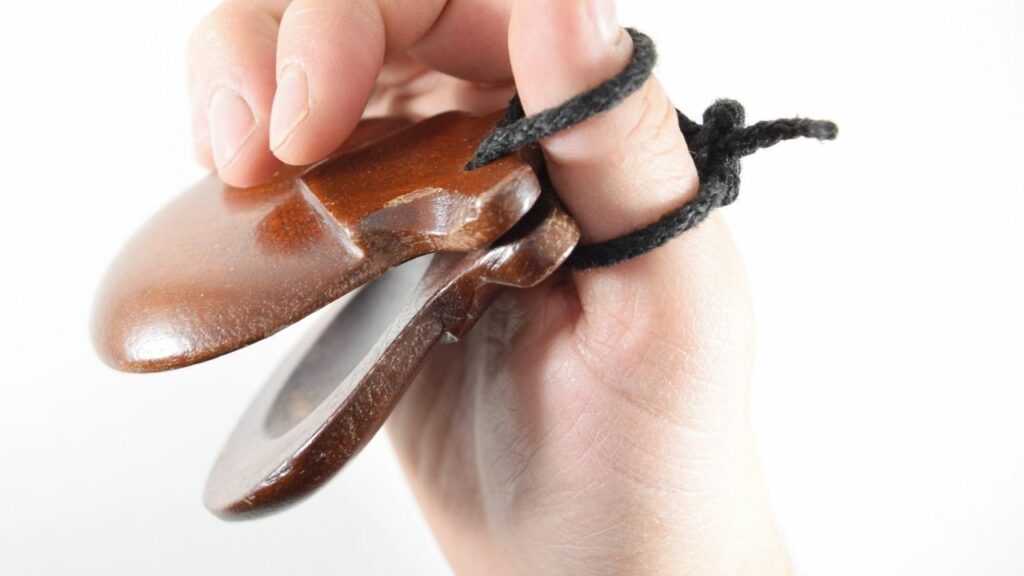
The castanet stems from the Mediterranean, although it originated in Phoenicia in about 1000 BC. This idiophone musical instrument comes with two hollowed-out shells, bones, or ivory held together by a rope. You can play castanets by inserting the loops through your thumb and then using your other fingers to close and hit the shells together.
Musicians play the castanets in pairs. The right castanet is called hembra, while the left one is referred to as macho. You can play both in the same beat or have one (the macho) for rhythm.
Chimes
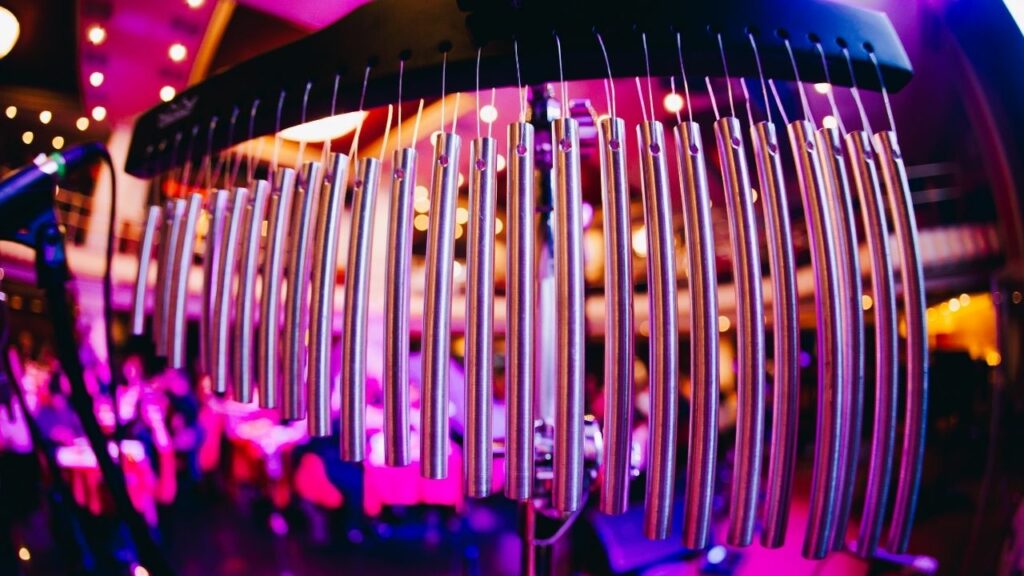
Chimes is also part of this idiophones instruments list, and it’s perhaps the most common. You will find it in churches, schools, offices, and other settings.
In an orchestra or band, a set of chimes may hang from a block of wood or sit on a platform of wood. To create the musical vibration, the player uses a small stick with a rounded end called a mallet. A set of chimes typically includes eight-round, metal chimes with a hollow center. This provides the player with a full octave range of notes.
Cowbell
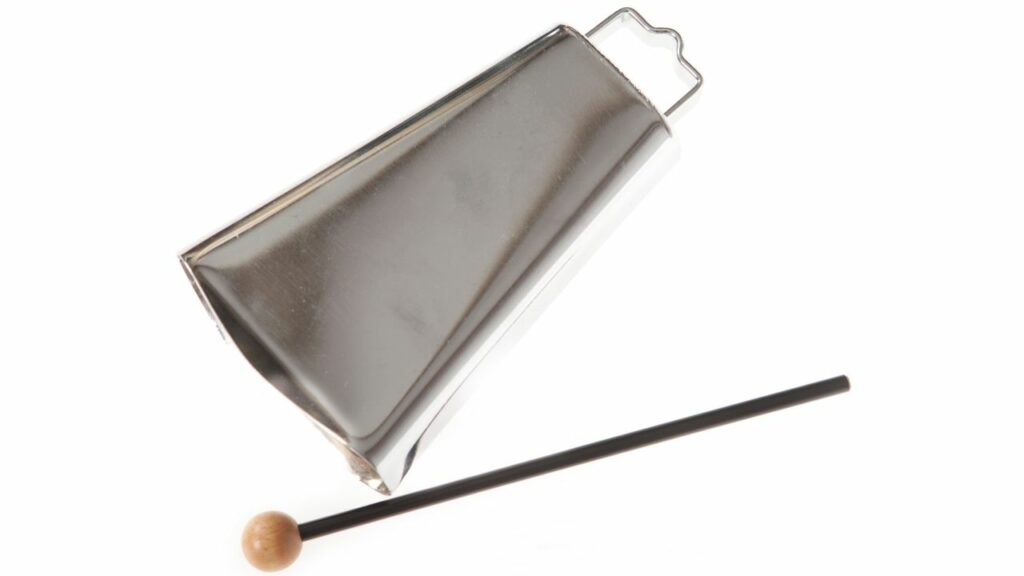
The single and double cowbell offer a hand percussive instrument that originally aided herdsmen in tracking their flocks. Those vibrations came from a metal mallet inside the metal bell hung on a cow’s or oxen’s neck. Classical music initially adopted the metal bell to create a quick, single note using a separate mallet to strike the outside.
Slit Drums

Unlike other percussion, these wooden drums is drum head free. As a matter of fact, a slit drum has a hollow sculpture with three narrow groves or slits shaped like an H. The ends of the drum are closed and typically can produce two different pitches.
Tubular Bells
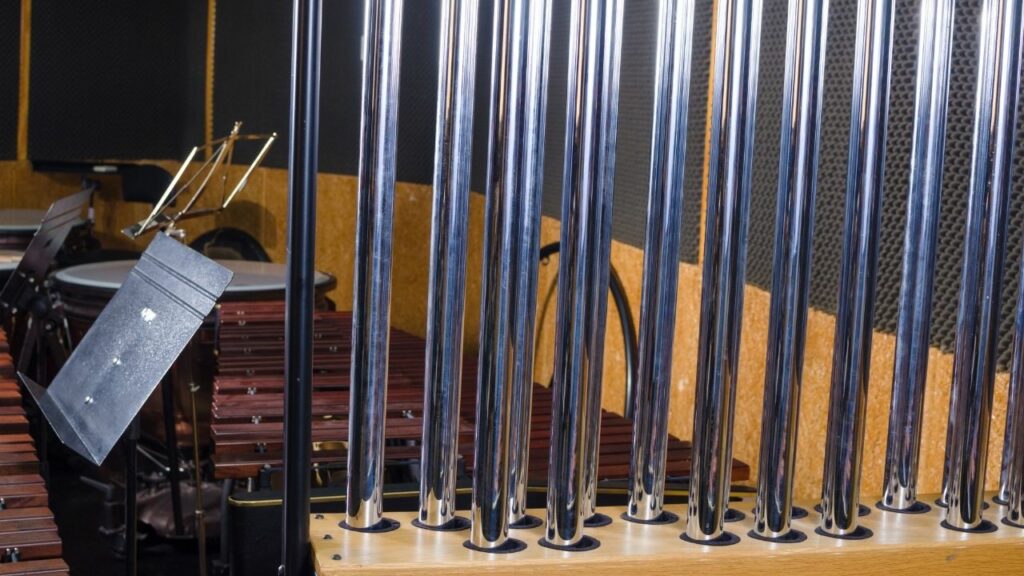
Tubular bells look like chimes when they take the hanging form but typically include a two-octave range or 16 distinct tube-shaped bells. A hand percussion version also exists though that resembles a pipe twisted into an X shape with one side solid pipe. Musicians also refer to tubular bells as orchestral bells. They emit a sound similar to church bells or a carillon when struck with a mallet.
Cymbals
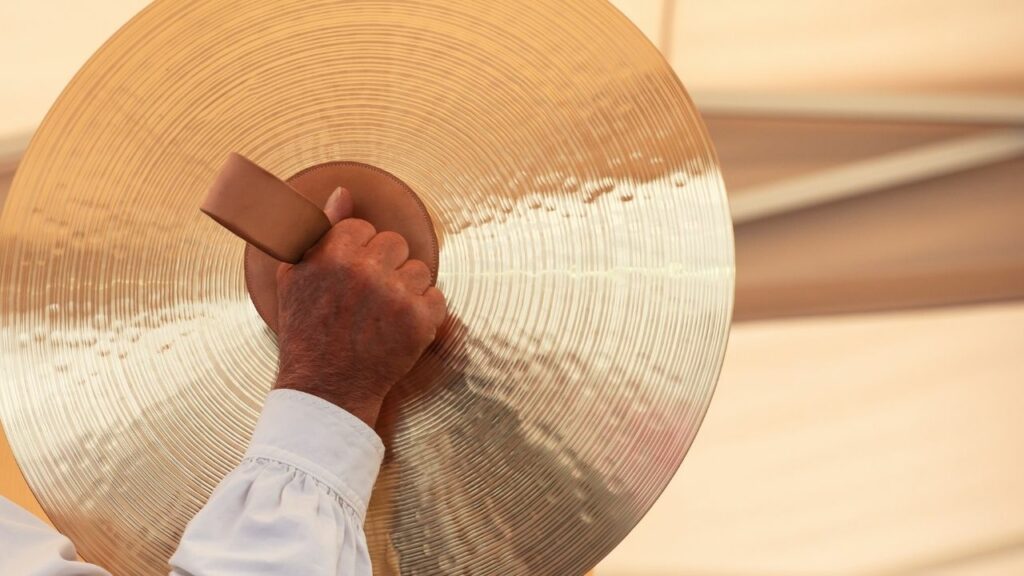
A cymbal may take the form of a single hollow round plate of metal or two such plates coupled so that the hollows meet. It may also attach to a rod and function as a part of a drum kit, such as rock and country band use.
There are hand-held cymbals that the player brings together to create a clashing sound. Cymbals offer a diversity, including splash cymbals, ride cymbals, crash cymbals, t-natural cymbals, etc.
Gong
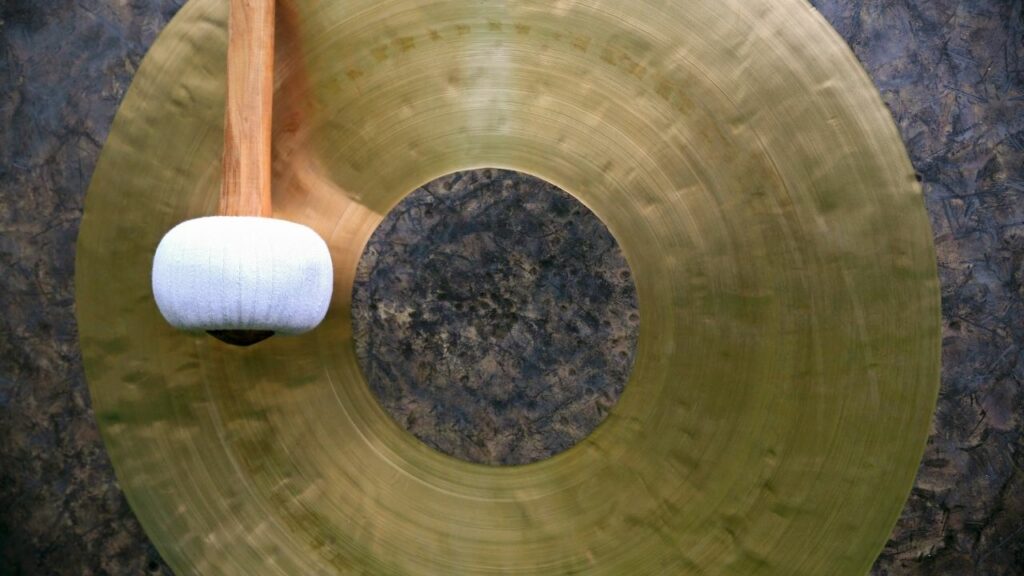
Originating East and Southeast Asia, this circular, flat disk struck with a mallet, issues a loud and resounding sound. The note of a gong sounds for many counts unless stopped. These large disks hang from a supporting post. Some progressive rock bands and jazz ensembles use the gong. The instrument became famous in popular times when featured on an entertainment show called The Gong Show.
Maracas
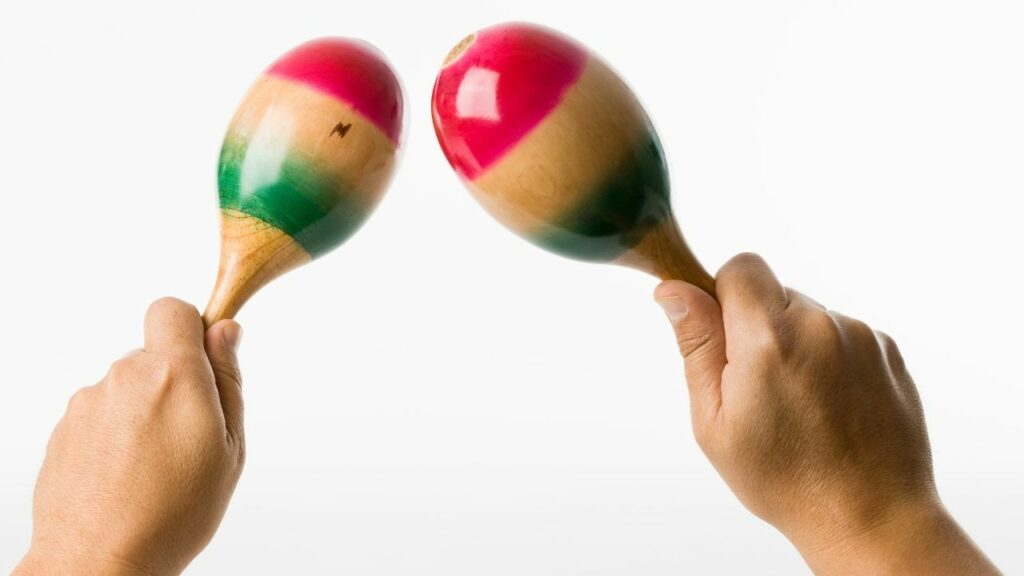
The gourd rattle called maracas stems from South American and Latin music, especially their orchestras. Typically egg or oval in shape, the objects sealed inside create a rattling sound when shaken. The materials used within the gourds vary from beans, stones to beads. Modern music also uses maracas crafted of leather, wood, or plant pods.
Marimba
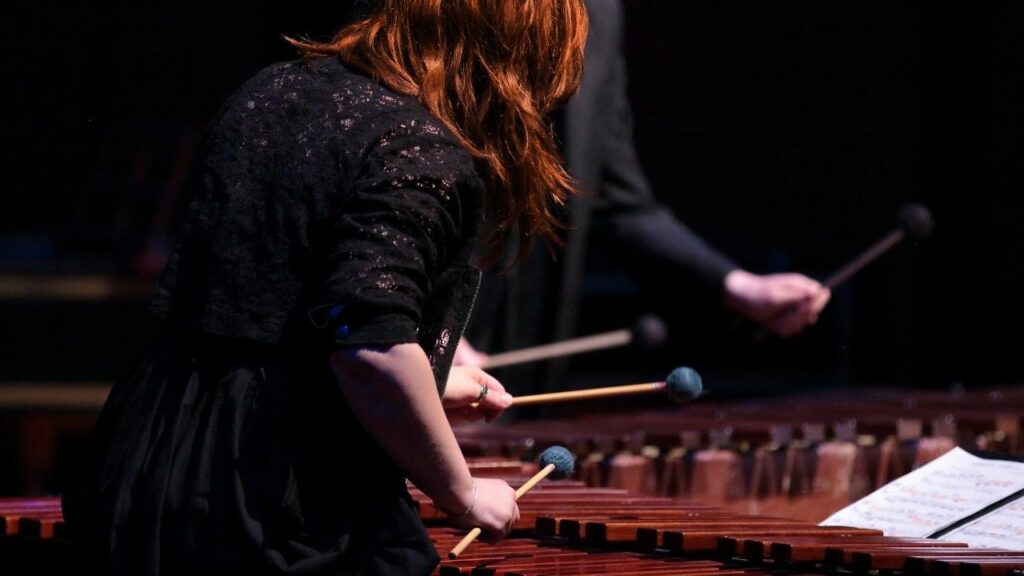
The African musical instrument the marimba strongly resembles a xylophone. A traditional marimba uses wooden bars with a tuned calabash resonator beneath each. In Latin America, musicians adopted the design but replaced the calabash with gourds.
When crafted for use in the orchestra, this six-and-a-half-octave instrument combines wooden bars attached to a frame with tube or metal resonators beneath each bar. Some marimbas hang around the player’s waist.
Vibraphone
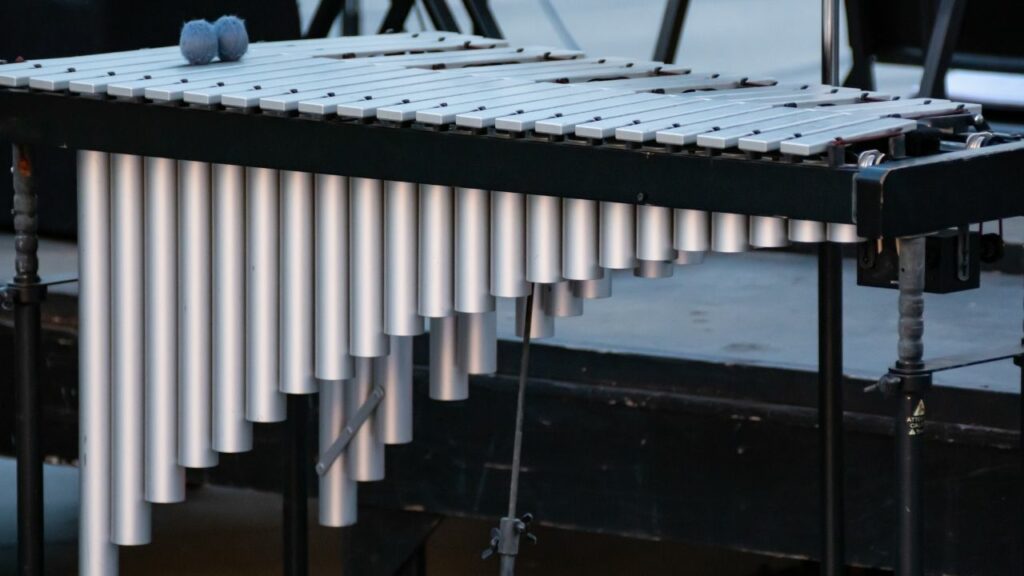
The musical instrument vibraphone, also known as the vibraharp or vibes, shares its shape with the xylophone. It uses metal bars and mallets covered in wool or felt to strike the metal which has a tuned, tubular resonator beneath it. Striking the metal creates a mellow tone. The resonator helps the vibraphone bars sustain the tones for long note counts.
Tambourine
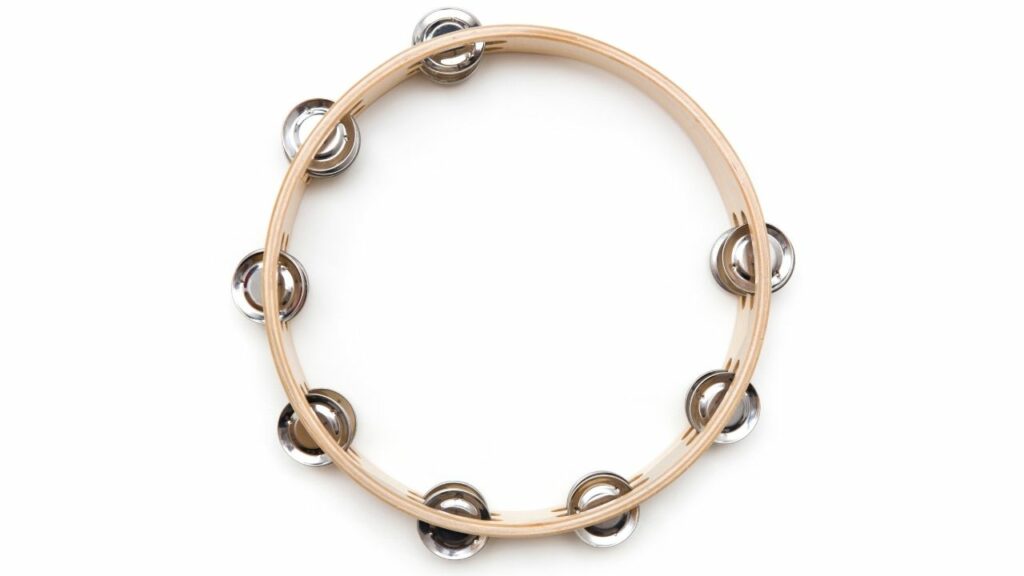
From the French word for drum, tambour, the tambourine consists of a wood frame with small pieces of metal called zils. When you shake the frame, the zils hit each other and produce sound. Some tambourines also have a drum head, but others do not.
Triangle

Triangle or triangle bell was traditionally a dinner bell. And, as its name suggests, it’s a triangular shaped idiophone instrument made from either steel or cast iron. You can play the triangle by hitting the triangle with a short metal stick.
Wood Block
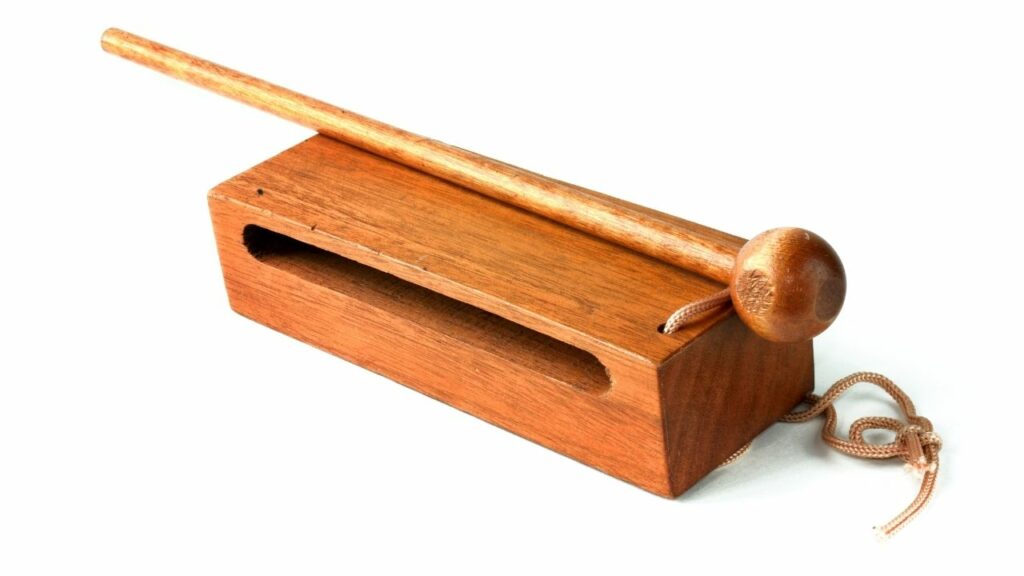
Wood block, as its name suggests, is an instrument featuring a block of wood. This common aboriginal instrument features a slit in its center and can produce sound when you hit with a mallet. This idiophone instrument is common heard in Dixieland music.
Handpan
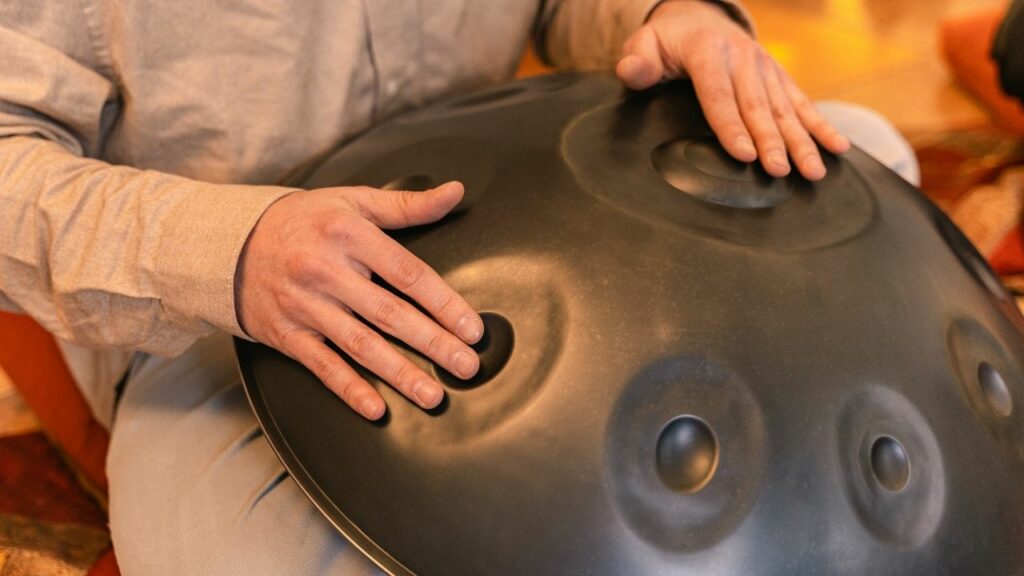
The handpan or hang drum only came to existence in 2001. This idiophone instrument uses a lenticular shape similar to a turtle shell or an upside-down wok. It creates a soft sound similar to raindrops when struck with your hand.
A hole on the bottom of the handpan provides the amplitude for the deep bass note of the instrument. Although easy to play, they have yet to catch on because they cost a lot to produce.
Xylophone
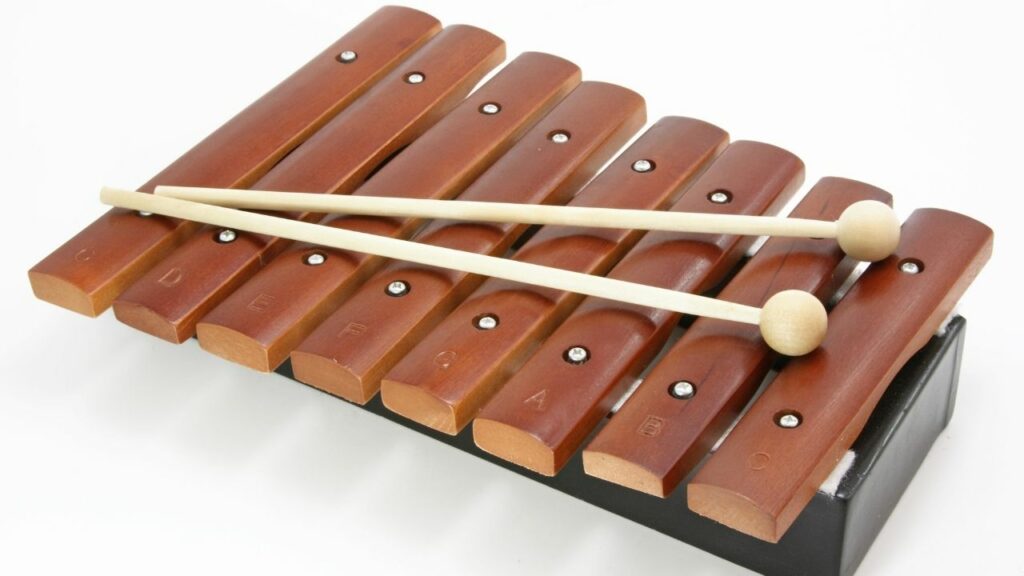
You can’t conclude an idiophones instruments list without the xylophone. It feature resonators beneath each wooden bar. So, when you hit this instrument with a mallet, it emits a note. This idiophone instrument typically includes more than three octaves.
Fun info: A metal version of a xylophone is called a Glockenspiel.
Brass Instruments
Trumpet

The trumpet is considered one of the most ancient members of the brass family. Starting out as merely a signaling instrument for different occasions, the trumpet has had quite an interesting evolution to become a present-day musical gem.
Being the smallest member of the brass family, trumpets produces the highest pitches by buzzing your lips into its mouthpiece. The instrument features a cylindrical bore for air intake and sliding tube (or valves) to alter the note produced.
Generally, in a symphony orchestra, there are four trumpets for melody and harmony, and are played in a horizontal position. You’ll also find trumpets in jazz bands.
Bugle
One of the most straightforward instruments in the brass family, the bulge is the simplest to handle and play. It features no slides or valves for pitch alteration. Instead, you have to rely solely on your embouchure to change the pitch accordingly.
The structure of the bulge is simply a metal tubing detailing a cup mouthpiece on one end and a bell on the other end. Thanks to its simple design, the bulge comes with only five notes. Its earliest version was made from animal horns and was commonly associated with the military.
Piccolo trumpet
The piccolo trumpet is the tiniest member of the trumpet family. Its length is half that of a typical trumpet but features a higher register range. That means its pitch is one octave higher than that of the standard Bb range. Thus, it ranges from D4 to G6 in high Bb.
Even so, that doesn’t mean the piccolo trumpet extends the range upwards, rather, it only makes your work easier when playing in the high register. That said, while some piccolo trumpets come with three valves, four is the accepted standard.
Cornet
The cornet is closely related to the trumpet because they play similar notes and almost produce the same sound. However, in appearance, the trumpet is slenderer and longer than the cornet. In terms of the tubing or bore, the cornet is more conical and hence produces a mellower sound.
That said, the cornet can be classified as an Eb cornet and a Bb cornet based on their pitches. Typically, an Eb cornet (soprano voice) is popular in brass bands and produces a higher sound than the Bb cornet. Thus, the Bb cornet is popular with solo work in both brass bands and wind bands.
Flugelhorn
The flugelhorn originated in Europe and boasts strong ties with the military. From ancient history, this famous cousin of the trumpet and cornet has continued to grow in popularity. Today, it is commonly found in jazz circles as an auxiliary instrument.
It comes with a more distinct conical bore compared to the trumpet and hence producing a mellower sound. The flugelhorn also features three piston valves whose fingering system matches that of the trumpet. It rose in prominence in the early 1900s.
French Horn/Tenor Horn
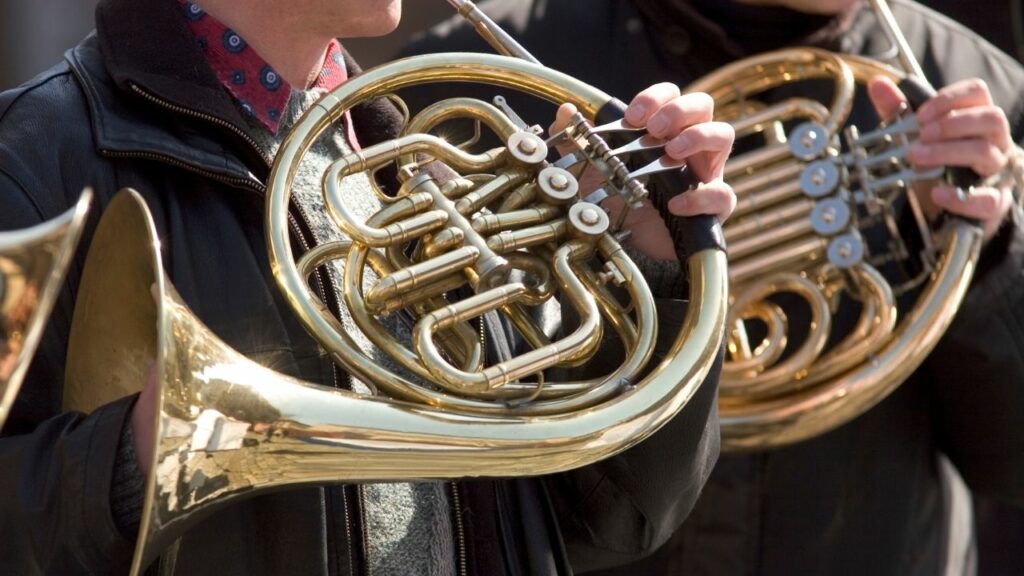
Next on the brass instruments list after the diverse trumpet family is the French horn or what is sometimes referred to as the tenor horn. In the musical circle, you may also encounter the term, “alto horn”. The truth is that both alto horn and tenor horn mean the same thing. It’s just that the latter is an English term, while the former is an American term.
That said, the French horn is an actual horn that dates back to the 16 century inspired by French and German hunting horns at the time. It is among the high-sounding instruments in the brass family characterized by a circular tubing terminating as a large bell.
Trombone
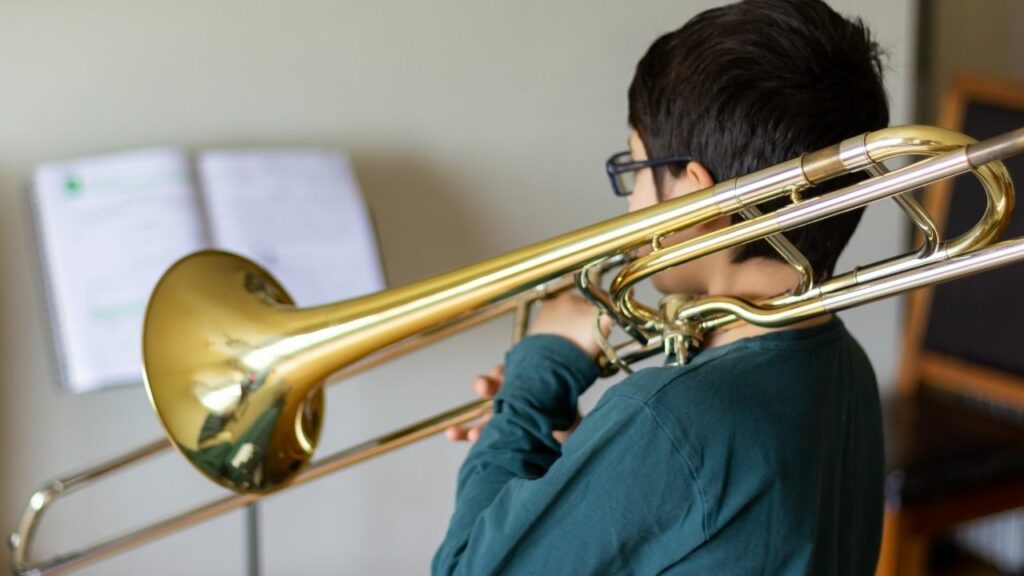
Rather than a conical bore, the trombone features a distinctive cylindrical bore that terminates into a flared bell. Another unique feature of the trombone is its use of a slide as opposed to valves or keys to alter the pitch. Thanks to the interconnection of long, slender brass pipes, sliding is possible to adjust the length of the instrument accordingly.
In terms of inception, the trombone was birthed in the mid-1500s and was originally called the “sackbut” (English) or “saqueboute” (French).
Tenor trombone
The trombone family comprises several members (mostly varying by size), key among them being the tenor trombone. It is the most popular of the trombone family and comes pitched in Bb. Moreover, the tenor trombone can further be classified as one with an F attachment and one without. Generally, the F attachment helps in altering slide positions on certain notes while providing a few lower notes.
Another distinction of the tenor trombone is that those with a single valve generally come with a larger bore than those without a valve.
Bass trombone
A close sibling of the tenor trombone, the bass trombone is also quite popular in modern orchestras. Just like its counterpart, it is pitched in Bb except it comes with two rotary valves. Thus, the name “bass” doesn’t have to sound confusing if you get this difference. Essentially, the two valves help the bass trombone to play lower than its brother.
In terms of size, the bass trombone boasts a larger bore, bigger mouthpiece, and bigger bell. Thanks to the wider bore, bass trombones make it easier to play low tones. Their big bells also mean they produce mellower tones than tenor trombones.
Tuba
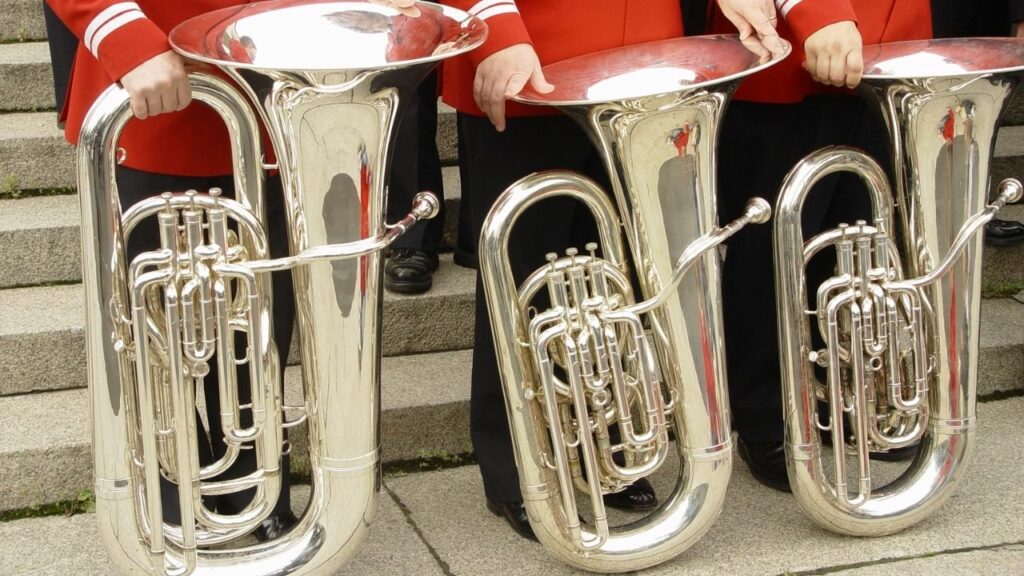
The tuba is not only the largest but also the lowest-pitched member of the brass family. Thanks to its enormous size, it easily stands out from its peers. It is crafted as a long brass tube with an oblong shape and terminates into a super large bell. It may have up to 6 valves.
Generally, tubas vary in length, and the longer the tuba, the lower the sound and vice versa. Further, an orchestra usually features a single tuba played while seated and placed on the lap.
Sousaphone
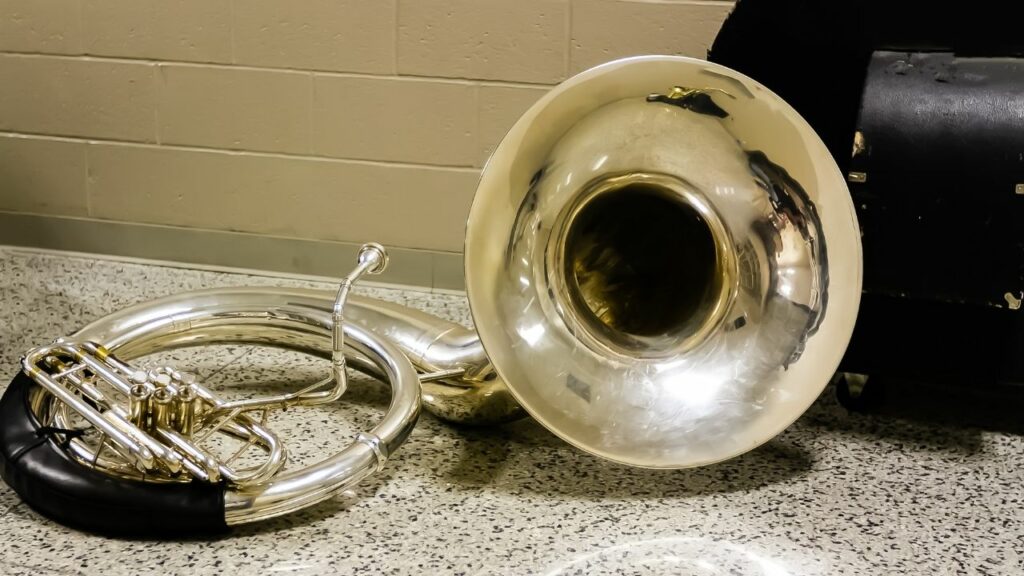
Common in marching bands, the sousaphone is a close companion to the tuba. However, while similar in range to the tuba, the sousaphone is specially designed for ease of use while marching or standing. Thus, the main difference between the two siblings lies primarily in their shape.
Although they have a similar tube length, the sousaphone boasts a unique circular shape that easily wraps around your body for easier carriage as you play. That means when used in a band setup, the sound of a sousaphone resonates over the players’ heads because its giant flared bell faces upwards.
Baritone Horns
Sometimes referred to as a mini tuba, the baritone horn or just baritone is a proud invention of the saxophone inventor. It came into being in the late 1700s and initially produced sound by striking glass rods. From there, it evolved as a member of the tuba family boasting a higher note range.
It features a sizeable tubing and three valves, and terminates into either a straight or curved bell. You can adjust the instrument’s pitch by altering the opening between your lips because the pitch depends on the volume of the vibrating air. Generally, shorter tubes produce higher sounds than longer ones.
Mellophone
The Mellophone is one unique member of the brass family specially designed for modern marching applications. In other words, it is optimized for outdoor musicality, projection, and playability. It features two or three keys and is mostly used in place of French horns because its sound dissipates faster outdoors.
In terms of appearance, the Mellophone features a bore with a distinct funnel shape and a tuning slide that functions just like the trumpet and other valve instruments. Because of its outdoor demeanor, the Mellophone is rarely used in performances.
Euphonium

The euphonium is a medium-sized member of the brass family characterized by a conical bore and three or four valves. It resembles a tiny tuba and plays one octave lower than the trumpet. What makes the euphonium stand out is its compensating mechanism or system that was developed in the 19th century.
The system essentially works by regulating the instrument’s intonation when the valves are pressed. It also simplifies the fingering process. The euphonium is a popular instrument in brass and military bands thanks to its unique middle voice sitting between a trumpet and a tuba.
String Instruments
Violin

First on our string instruments list is the violin.
This string instrument’s history dates back to 16th-century Italy. Most scholars credit lute builder Andrea Amati of Cremona as the inventor. However, the exact creator is still unknown.
This string instrument, also referred to as a fiddle, is known for its hollow wooden body and high-pitched sound. Of course, it is also famous for how it is played. When playing the violin, you’ll need to use your chin to hold it in position. Using your right or left hand, you’ll glide the bow across the strings while your other hand holds the neck. You’ll need to press the strings as you move the bow to create varying sounds.
Drawing the bow over the strings is not the only way you can create a sound. Other musicians pluck the strings (pizzicato), while others use the bow’s wooden side to strike the strings (col legno).
Fun fact: In an orchestra, soprano tones are from the violins. The tenors are from the viola and cello.
Viola
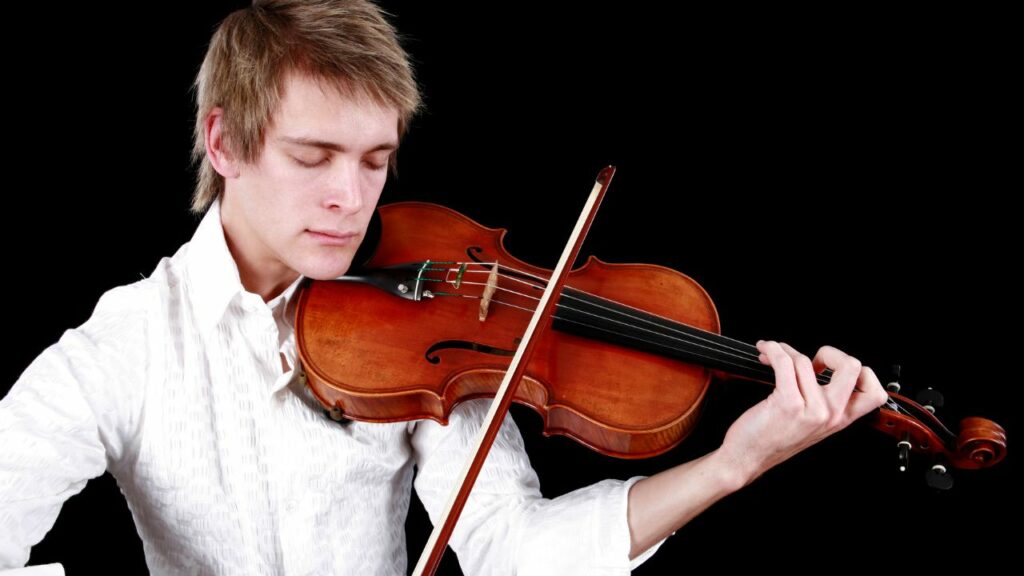
The viola is the larger counterpart of the violin – 1″ to 4″ larger, to be more precise. Since it is bigger, it doesn’t have the iconic high pitch sound of violins. Instead, it registers a lower and deeper range. As a matter of fact, musicians and scholars consider the viola as the alto voice or the middle ground between a violin and the cello. Like a violin, you can play the viola by bower or plucking.
Fun fact: Viola, cello, double bass and the violin are part of the violin family.
Cello
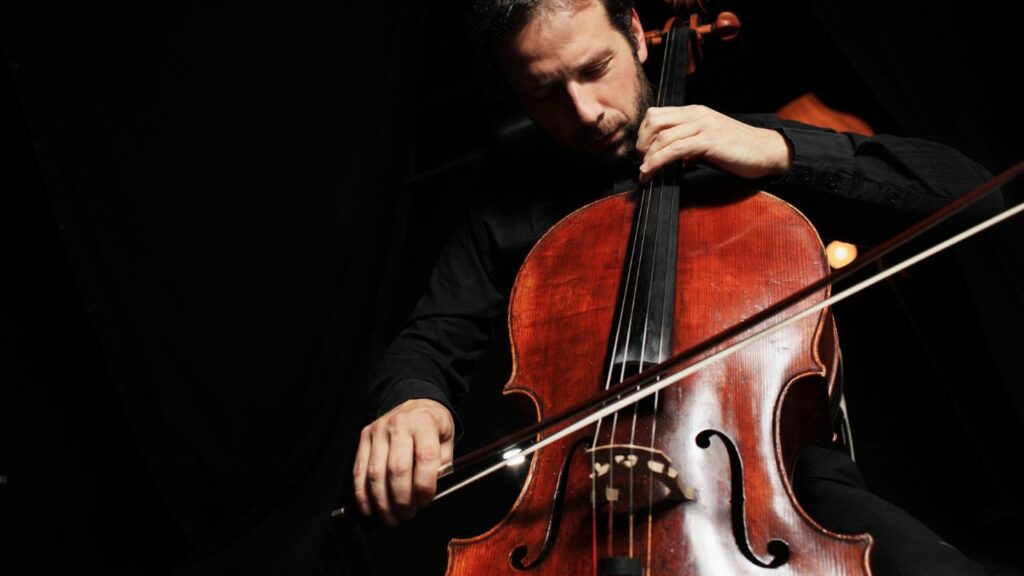
Cellos feature strings tuned in perfect fifths, making them the lowest-toned stringed member in an orchestra. Naturally, its music is written in the bass clef but sometimes has passages from higher. You can play the cello using a bow, but like the violin and viola, you can pluck or hit the strings to produce a sound. In addition, their endpin is similar to the double bass resting on the floor.
Fun fact: Out of the string instruments list, the cello has the closest human voice-like tone. And, it’s not unusual for an orchestra to have up to 8 cellos!
Double Bass
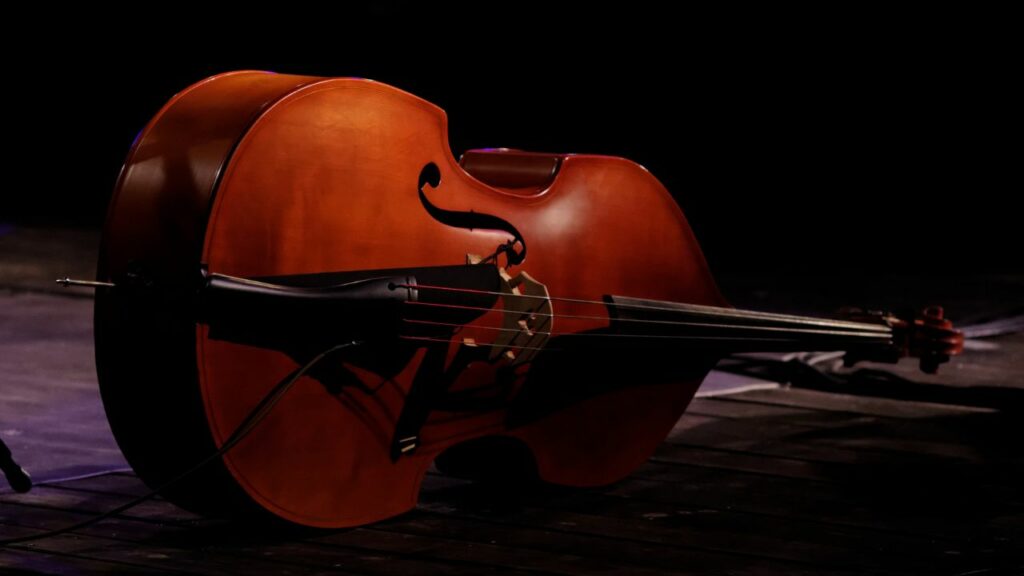
The double bass is a noteworthy stringed instrument because it’s the only bowed instrument with a fourth-based tuning. It is also the largest, measuring about 6-feet from the endpin to the scroll.
Musicians typically use an arco or bow along the strings to play musical pieces. Nevertheless, some will use a pizzicato playing style, especially during staccato sections. Classical players also often employ a fortissimo dynamic, creating dark, heavy tones. Originally,
Fun fact: Double bass produces the bass tones, not the cello.
Harp
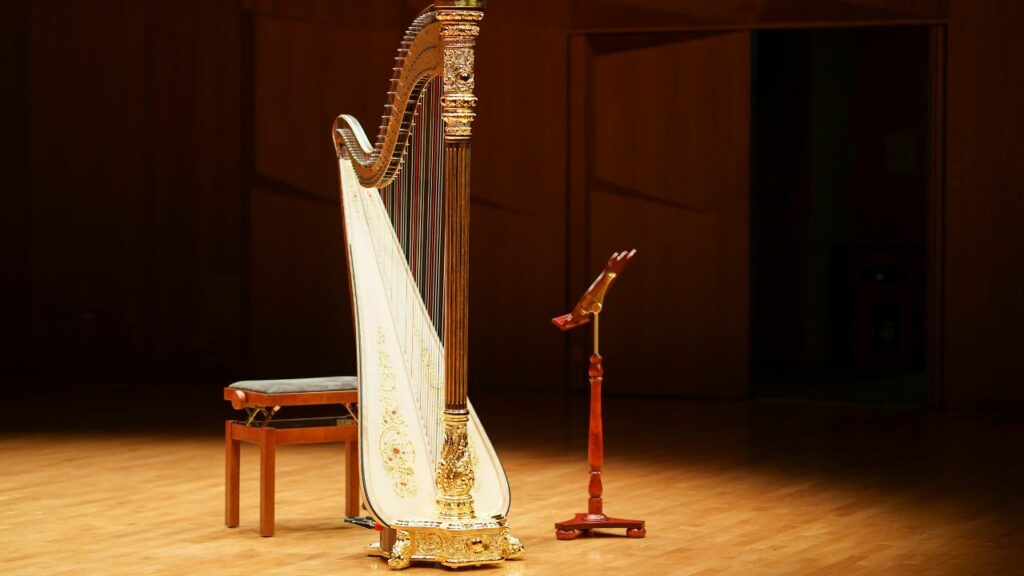
Also included in our string instruments list is the harp. It is a plucked string instrument with several strings running at an angle to the soundboard. The harp is divided into two main types – lever and pedal.
Lever harps have sharping levers (a mechanism that allows you to raise the pitch of the strings) on top. On the other hand, a pedal harp, as its name suggests, features a pedal at the base that you step on to change the notes. For classical music, musicians typically play the pedal harp.
Banjo
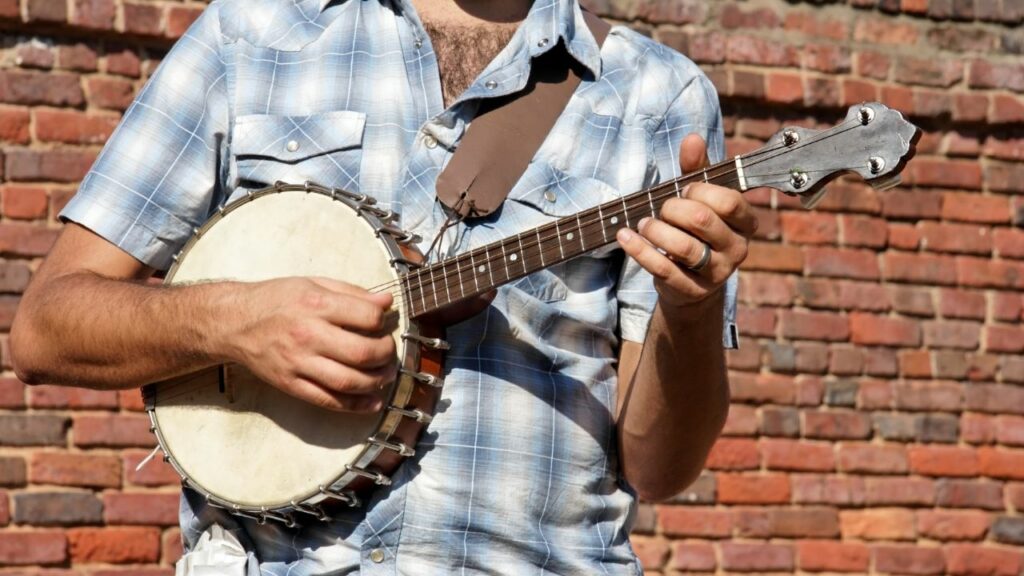
A string instruments list wouldn’t be complete with the banjo. This stringed instrument is known for its long neck body and round head. Unlike other stringed instruments, banjos feature a stretched thin membrane or parchment on their circular body. Think of it like a tambourine but with a neck and strings. Banjos are common in folk music.
There are many types of banjos, including 4-string banjos, 5-string banjos, 6-string banjos, and even 12-string banjos.
Mandolin
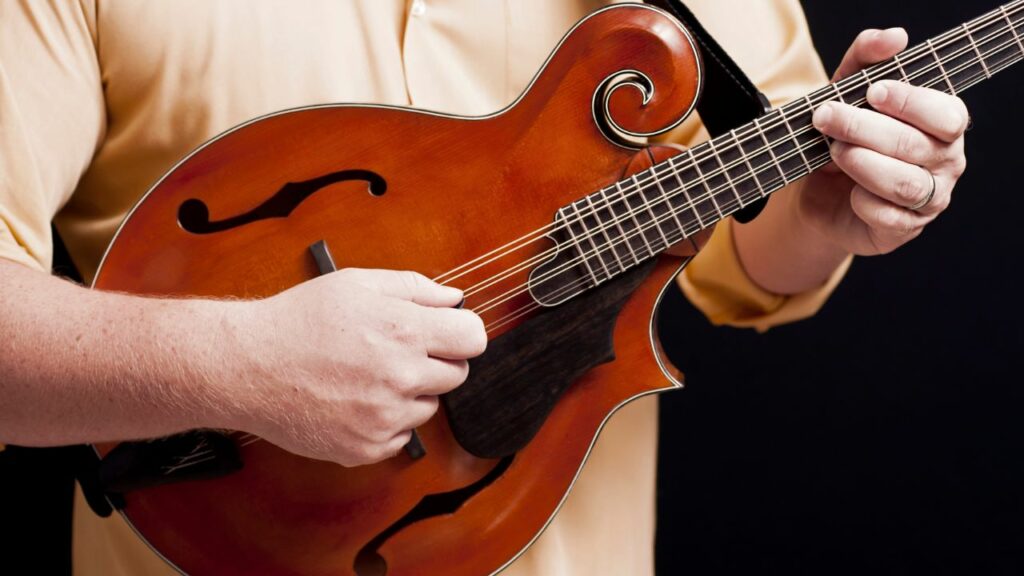
A typical mandolin has four sets of doubled strings, totaling eight overall. The Neapolitan, arch-top, and flat-backed styles are the most widespread, although more exist. Classical European songs implement Neapolitan versions, while bluegrass uses arch-top ones. Its body amplifies sounds produced by strings, acting as a resonator. Tremolo picking compensates for the instrument’s fast note decay, so it is used in tons of songs.
Ukulele

Portuguese luthiers invented the ukulele, but Hawaiians popularized it later on. Tone and volume vary with the instrument’s size and construction, and there are four sizes – soprano, concert, tenor, and baritone. They resemble small acoustic guitars, having a figure-eight body in terms of shape.
Guitars
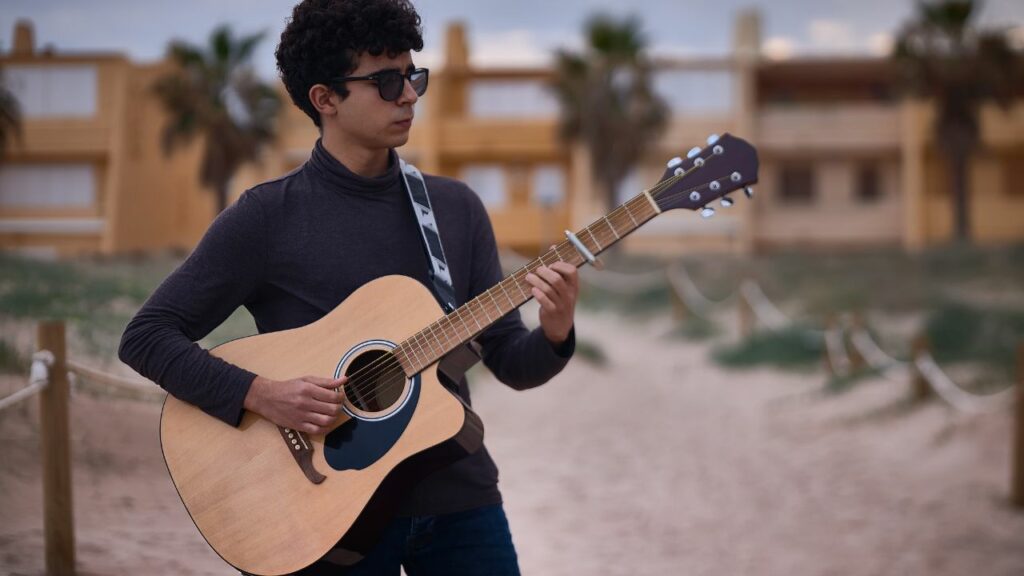
This group will comprise a substantial entry on our stringed instrument list. Guitars represent a broad range of fretted instruments usually made with six strings. When played, it rests flat against the player’s stomach, and they strum with the dominant hand.
Electric guitars
Electric guitars have either magnetic pickups or piezo pickups. These components are responsible for converting the vibration from the strings into an electric current. Without them, you won’t hear any sound from an electric guitar. This is also the reason why you’ll find an electric guitar hooked up to an external amplifier.
You can find electric guitars in many genres, but they are more common in punk rock, heavy metal, alternative rock, and even blues.
Classical guitars / Spanish guitars
Classical guitars or Spanish guitars are the precursors to today’s acoustic and electric guitars. It doesn’t have any pickups or requires any other component to produce sound. So, what’s the difference between an acoustic and a classical guitar? The latter uses nylon strings, creating a softer and follower sound. Other differences include a thicker and wider neck and a wrap-around bridge.
Acoustic guitars
Acoustic guitars evolved from classical-style guitars popular during the 19th century. They transmit sound by vibrating strings, generating noise in the body. The guitar’s hollow shape resonates with the sound, increasing its volume substantially. Strings may be struck one at a time, or a player can strum them all to create chords. Furthermore, the wood used to make an acoustic guitar’s soundboard influences its timbre.
Bass guitar
Beginning in the 1950s, the bass guitar began replacing the double bass in popular music. A luthier usually adds four strings to the bass guitar’s body, but there are five-string models. Electronic pickups are installed beneath the strings and mounted on the body.
When played, electronic signals transmit through these and into an amplifier, creating sound. Paul Tutmarc of Seattle introduced the world’s first electric bass in the 1930s. Prior to his introduction, the double bass was standard in the most popular music. Audiovox sold a 30.5-inch model in their 1935 catalog, and it had a single pickup in the body. In total, they produced around 100 during this time.
Sitar
A sitar’s design can incorporate 18, 19, 20, or 21 strings. Interestingly, six or seven of these strings must run over curved, raised frets. Sympathetic strings compose the remainder, running beneath the frets and resonating in sympathy.
Lute
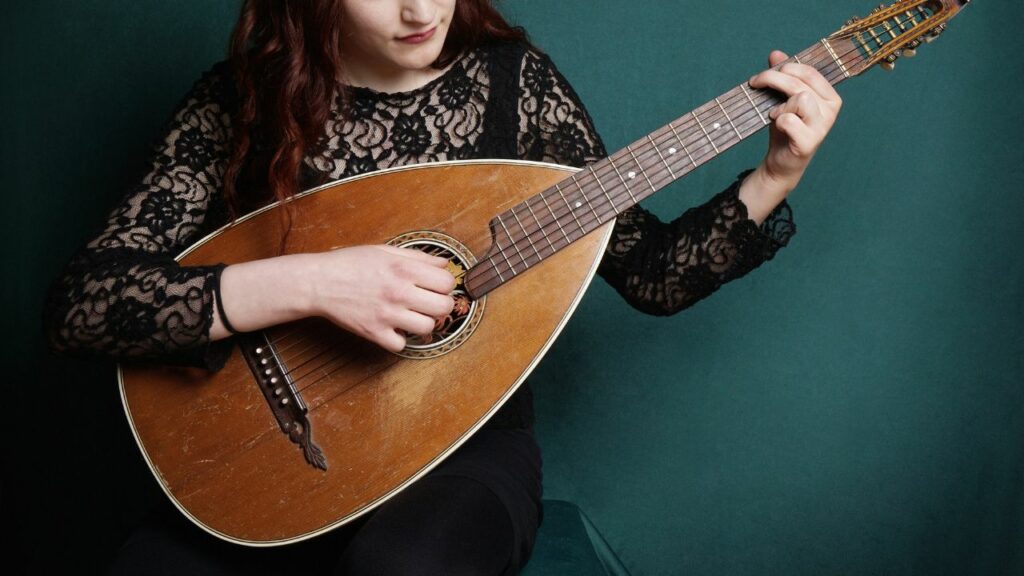
Lutes encompass any plucked string instrument with a neck, round back, and an enclosed cavity. Sometimes, they do not possess frets, but some of them are fretted. Consequently, ebony is a frequent choice for the veneer when making the fretboard.
Since the neck is a light wood, this adds strength, stability, and durability. On the other, its tuning pegs are hardwood, tapering toward the ends. Its popularity peaked during the middle ages in Europe but was revived in the early 1900s.
Oud

Several ethnic instruments are on this stringed instrument list. Ouds are short-neck lutes with pear-shaped bodies, completely lacking frets. In many cases, they have been built with 11 strings grouped in six courses.
Nonetheless, some choices have featured five or seven courses, and up to 13 strings can be used. Playing styles usually require a plectrum, but some players strum without them. It is symptomatic of Arabic music and is equivalent to the European lute during the same era.
Dulcimer
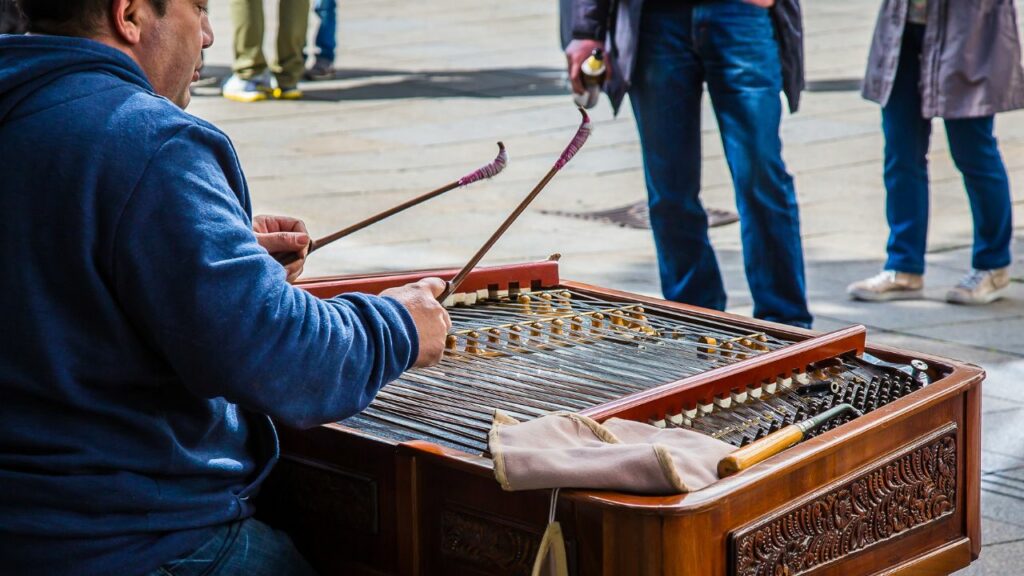
Hammered dulcimers are hybrid percussion-stringed instruments. Dulcimer makers stretch strings across a trapezoidal resonant soundboard. If you want to play this stringed instrument, you will need to strike a small hammer or mallet to its strings.
Traditionally, a dulcimer’s design has incorporated two bridges, coming in various sizes. A 15/14 will use 15 strings to cover the treble bridge and 14 to cross the bass bridge.
Bottom Line
When it comes to choosing a musical instrument, there are a lot of options out there. But by looking at the list of musical instruments list, you can better understand what’s available. So don’t be afraid to experiment with different instruments until you find the right one. Who knows, you might surprise yourself.
Table of Contents






